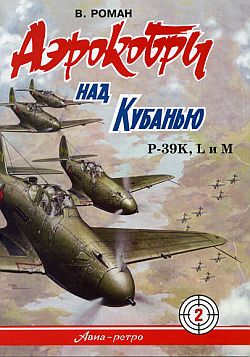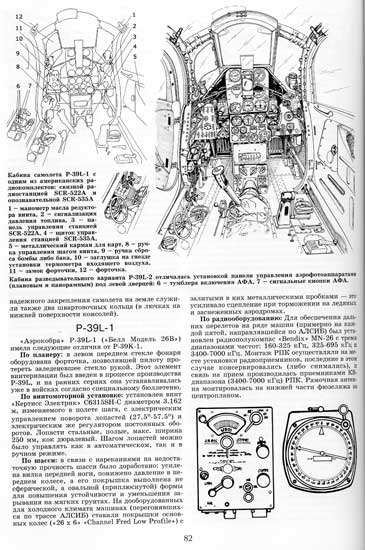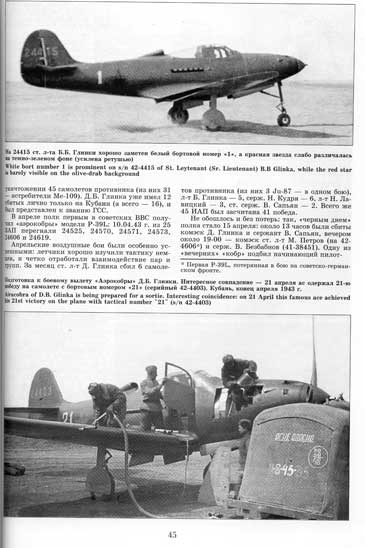 Aerokobry
nad Kuban'yu (Airacobras over Kuban')
Aerokobry
nad Kuban'yu (Airacobras over Kuban') Aerokobry
nad Kuban'yu (Airacobras over Kuban')
Aerokobry
nad Kuban'yu (Airacobras over Kuban')It is traditionally believed that the best information sources on an airplane or vehicle should come from the country of the plane's or vehicle's origin; this time we definitely deal with a happy exception to this rule. And, after all, the Airacobra had seen so much service with the VVS that it would be no serious distortion of the truth to say it was a Soviet aircraft probably to the same extent it was the American one. As if trying to confirm this, the reviewed book published in Eastern Europe outscores everything I have seen and read on the P-39, including the US-published stuff.
 Just
a reminder, V.Roman aka Valery Romanenko is a well known VVS researcher who
undoubtedly is one of the best lend-lease aircraft specialists, and I am sure
many VVS history fans do remember his first book of the "Avia-retro"
series, "Aerokobry vstupayut v boy" ('Airacobras enter combat') published
in 1993 and dealing with early "snakes" with 20mm cannon (Airacobra
I/P-400 through P-39D-1/-2). What we have now is the second book of the same
series. The new book inherited the manner of presentation, the depth of research
and the attitude but, very fortunately, there is little resemblance between
the old and the new book speaking of the style and quality of print. The recent
one is done on a high quality paper, full A4 size, allowing a very good reproduction
of photos.
Just
a reminder, V.Roman aka Valery Romanenko is a well known VVS researcher who
undoubtedly is one of the best lend-lease aircraft specialists, and I am sure
many VVS history fans do remember his first book of the "Avia-retro"
series, "Aerokobry vstupayut v boy" ('Airacobras enter combat') published
in 1993 and dealing with early "snakes" with 20mm cannon (Airacobra
I/P-400 through P-39D-1/-2). What we have now is the second book of the same
series. The new book inherited the manner of presentation, the depth of research
and the attitude but, very fortunately, there is little resemblance between
the old and the new book speaking of the style and quality of print. The recent
one is done on a high quality paper, full A4 size, allowing a very good reproduction
of photos.
The new book covers models K through M, the mid-production Cobras, which were delivered in numbers to the Soviet Union. The book starts with a brief account of development and service of early models (C/D/P-400) which looks appropriate since the first issue has long been out of print and is not too easily available. Part 2 dwells on an uneasy history of shipping the P-39K/L/M to the USSR, followed by the story of combat service of the type in the VVS and Naval aviation as well as test accounts from the Air Force Research Institute (NII VVS). Part 3 presents the technical description of the P-39K/L/M and contains a few drawings of cockpits, equipment, armament etc. In particular, this is the first time separate cockpit drawings for each version considered are presented.
The color paperback cover provides 3 pages of nicely made color profiles, and I am sure many of these will cause substantial modellers' interest. For instance, among them you'll find A Pokryshkin's first P-39K Airacobra that he flew in time of Kuban' air battle (spring 1943) claiming 17 German aircraft.
 Here
is what I would like to single out as big values the book brings up:
Here
is what I would like to single out as big values the book brings up:
Photographs. Over 70 pictures of excellent quality, including a big number of wartime shots of planes in the US and Soviet service and a nice little walkaround of the Niagara Falls Museum's Q-15 done by Ilya Grinberg
Thoroughness of research. The author tracks all units that used the subtypes in question, lists deliveries, sorties, losses and writeoffs, quotes serial numbers. In my opinion, the job Valery has done could be considered as a pattern to follow when doing a similar research.
The book has an insert of 4 A3-sized pages with highly detailed scale drawings that are done very well and reportedly could beat all earlier efforts on accuracy.
The text is in Russian, all photos have Russian and English captions.
The book is strongly recommended to everyone interested in the P-39 and in the Soviet Aviation History. My congratulations and best wishes to Valery Romanenko who will hopefully continue with the P-39N and Q some day. No doubt the follow-up is going to be exciting.